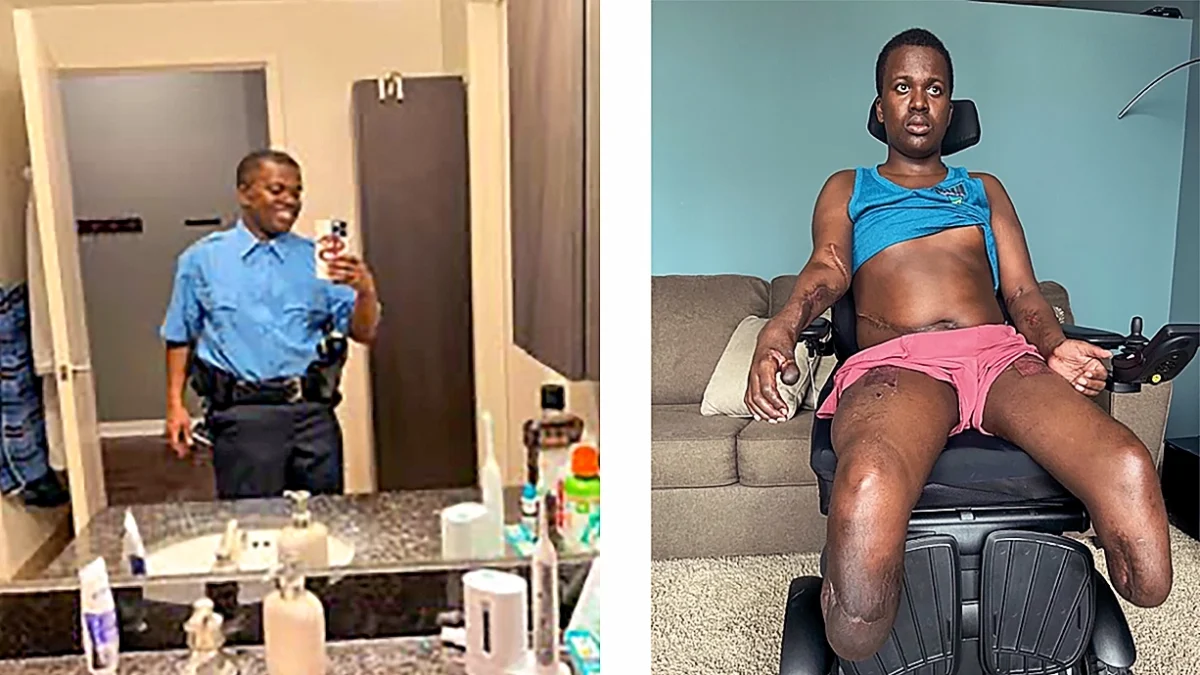Victor Moses’ dreams of becoming a Denver police officer were shattered after the recruit was ordered to go through a “barbaric hazing ritual” that led to the amputation of both his legs as well as the ability to even care for himself.
Now the 29-year-old Black man is suing, accusing the Denver Police Department of covering up their hazing ritual known as “Fight Day” by claiming he had an undisclosed medical condition known as sickle cell trait that led to the amputation of both legs below the knees.
But Moses had disclosed he had sickle cell trait in his application to the Denver Police Department, according to the lawsuit filed on July 30, 2024, where he explained in a section asking about blood disorders that “both my parents & I have the trait but never had any problems.”

Sickle cell trait is an inherited medical condition that affects up to 10 percent of Black people in the United States in which patients carry a defective gene, causing the production of abnormal hemoglobin, according to the American Society of Hematology.
However, it is not as severe as sickle cell disease, which is when patients have two genes that lead to abnormal hemoglobin, the substance in red blood cells that help carry oxygen.
Yet, sickle cell trait can still lead to serious complications in “cases of athletes with sickle cell trait who have experienced exertion-related illness and, in some cases, sudden death, during or after strenuous athletic training sessions,” the American Society of Hematology explains.
The lawsuit states that “Dr. Kelsey Smithhart at Denver Health cleared Mr. Moses in July 2022 to participate in the Academy training regimen, including ‘Fight Day,’” which indicates both police and doctors were well-aware of his medical condition.
As a result, his entire life has been turned upside down, the lawsuit explains in great detail:
He spent over four months bedridden in the hospital. He has undergone many surgeries, including below the knee amputations of both legs, multiple fasciotomies, and arm surgeries. He also suffered severe internal injuries to multiple organs, which continues to require significant medical care. In July 2024 he underwent major surgery for about 8 hours in an effort to restore some gripping function in one hand.
Mr. Moses now has prostheses which often bleed when he uses them, requiring him to endure the daily risk of infection and further amputation. His arms and hands are severely compromised. The pain he has consistently experienced is truly incomprehensible, requiring daily high doses of pain and other medications. His injuries and damages caused by the events of January 6, 2023, are profound and lifelong.
Victor Moses did not become a police officer. Fight Day rendered him permanently and severely disabled.
“Designed to Induce Stress”
Moses’ claim describes what happened when he joined the academy and the events that led to his catastrophic injuries. He moved to Denver after graduating from Florida State University and applying with the city’s police department in early 2022, passing all the necessary background checks. He was hired but was required to complete the police academy before becoming a police officer.
Before they are allowed to graduate from the police academy, recruits are required to participate in “Fight Day,” officially known as a Dynamic Action Drill (DAD), according to the lawsuit.
The purpose of the drill is to train officers in “scenario-based drills, which are supposed to train and test them on arrest control techniques.”
But the training also subjects recruits to beatings, chokeholds and ridicule, according to past recruits mentioned in the lawsuit.
It is “designed to induce stress on the recruit’s cognitive abilities that will armor them against overactivation of the Sympathetic Nervous System (SNS) in future high stress situations,” the lawsuit states.
On Jan. 6, 2023, about 40 police recruits participated in Fight Day, with several of those recruits later breaking the blue wall of silence and speaking on the record about how Moses was forced to continue participating in the training despite clear signs he was physically unable to do so.
Four Stations
The training is broken down into four “stations” that are supposed to last eight minutes altogether.
Station 1 is the Combatives/Defensive Tactics stage and is supposed to last two minutes, requiring the recruit to repeatedly deliver punches, kicks and knee strikes against a standup dummy or instructor protected by pads for the entire duration of the stage. The main purpose of this drill is cause the recruit to become physically tired in order to build up their endurance.
Station 2 is the Baton Endurance Drill and is supposed to last 90 seconds, requiring the recruit to step into an area with a padded baton to fight four officers who attack the recruit with the batons.
Station 3 is the Ground Fighting Drill, which is supposed to last two minutes and requires the recruit to remove all protective gear and be placed on the ground, where an officer maintains a dominant position.
And Station 4 is the Arrest Scenario Drill that is supposed to last 2 1/2 minutes and thirty seconds and requires the recruit to intervene in an altercation between two officers, one who is pretending to assault the other. The main aggressor then turns on the recruit who is then required to handcuff and detain the aggressor.
It was during Station 2 that Moses ended up knocked down several times by a cop named Stephen Marino, who drove him off the mat, causing Moses to strike his head on the hard tile floor. It was obvious to the other recruits that he was struggling to remain standing, collapsing several times before finally losing consciousness.
When paramedics on the scene checked him out, Moses told them he was “extremely fatigued” and experiencing “extreme leg cramping,” which could be signs of sickling of his red blood cells. His blood pressure was also 90/60, which is extremely low for someone having just gone through such extreme physical exertion.
However, the paramedics told police he could continue participating in the drills despite being unable to stand due to his “spaghetti legs.”
During Station 3, when Brian Camozzi was laying his full body weight on Moses, the recruit gasped, “I can’t breathe,” before becoming limp and unresponsive, which was when he was transported to the hospital, where he remained for four months.
Denver police told doctors that they were unaware of what led to Moses’ unconsciousness because he had not suffered any “direct trauma.”
But despite the attempted cover-up, several recruits who witnessed the abuse decided to speak out.
“I mean the bulk of us witnessed him fall head first on the tile, they don’t have much of an argument against it,” wrote recruit officer Zachary Vasquez on a recruit group chat shortly after Fight Day.
“Best thing we can do is give an honest account of what we saw. An utter lack of care for the well-being of recruits,” Vasquez added.
“If they try to say something different, I won’t let Moses go out like that,” said recruit Jacob Mills. “They need to be accountable for their actions.”
The recruits’ descriptions of what they saw conform to Moses’ attorneys’ assessment of the training event: “While ‘Fight Day” purportedly provides necessary police arrest and seizure training, in reality, it has become a barbaric hazing ritual.”


